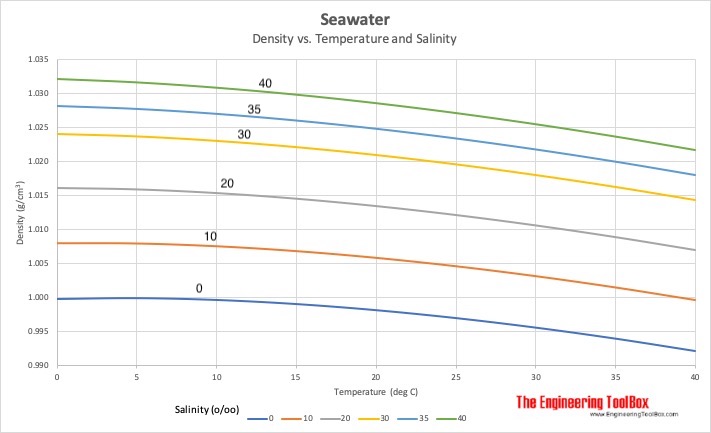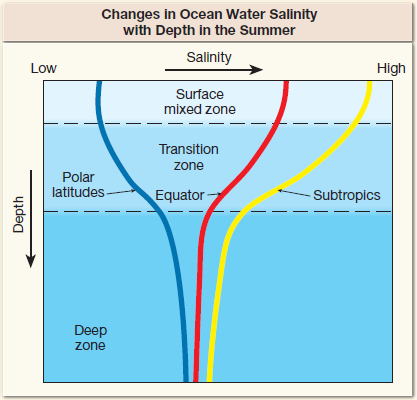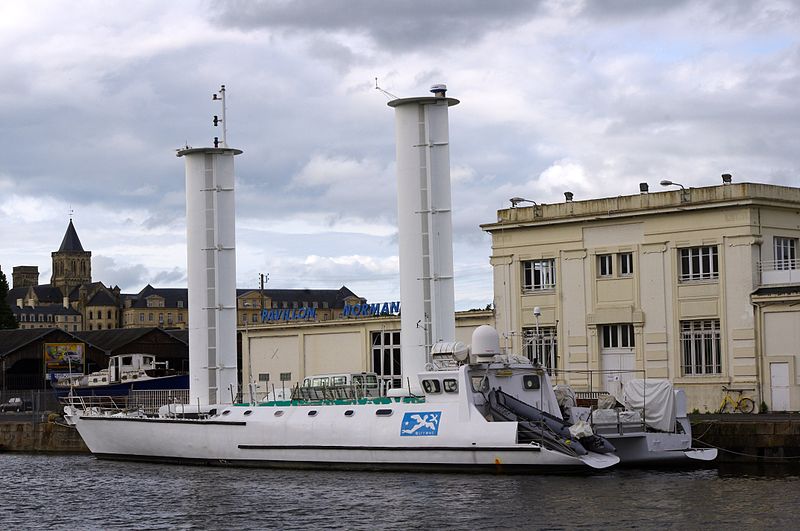You are using an out of date browser. It may not display this or other websites correctly.
You should upgrade or use an alternative browser.
You should upgrade or use an alternative browser.
OTEC
- Thread starter svetz
- Start date
D
Deleted member 165
Guest
Fascinating! Especially the desalinization aspect. My question is, how much power does it take to pump the water, relative to the output, in a fixed location situation? Obviously geography would be the main limiting factor here. I'm 2,500 miles from the ocean. What size wire would I need? 
The low efficiency seems to be offset by the free fuel. Recent advancements in UV treatment could potentially solve the biofouling issue? Thanks for sharing this. The possibilities seem to be endless.
I've been thinking about how to harness the power of the tides coming in/out lately as well. There must be some potential there, but it't beyond my brain.
The low efficiency seems to be offset by the free fuel. Recent advancements in UV treatment could potentially solve the biofouling issue? Thanks for sharing this. The possibilities seem to be endless.
I've been thinking about how to harness the power of the tides coming in/out lately as well. There must be some potential there, but it't beyond my brain.
Energy for the pumps should be a very small percentage of the energy gains. There is essentially no "head" pressure, just pipe friction losses.
Yes, a very cool concept, and it's nice to know that there are actual pilot plants operating. I enjoy watching Joe's channel.
Yes, a very cool concept, and it's nice to know that there are actual pilot plants operating. I enjoy watching Joe's channel.
D
Deleted member 165
Guest
Energy for the pumps should be a very small percentage of the energy gains. There is essentially no "head" pressure, just pipe friction losses.
Yes, a very cool concept, and it's nice to know that there are actual pilot plants operating. I enjoy watching Joe's channel.
No head pressure difference from piping cold water from below? How do you figure?
The entire pipeline is submerged, so both sides of the pipe loop have the same static water pressure. By "head" I mean the small portion of pipe that is above sea level. And that is likely insignificant because I assume the pipe, even above sea level, is filled solid with water including the return side.
I.e., the pipeline full of water has the same static pressure on the "down" side into the sea as on the "up" side, so the net pressure is zero. You need energy to move the water around (against pipe friction losses), but not to "lift" it. Consider how a siphon works - both sides of the hose are full of liquid, but "balanced" and not flowing when the water levels are the same at both ends.
I.e., the pipeline full of water has the same static pressure on the "down" side into the sea as on the "up" side, so the net pressure is zero. You need energy to move the water around (against pipe friction losses), but not to "lift" it. Consider how a siphon works - both sides of the hose are full of liquid, but "balanced" and not flowing when the water levels are the same at both ends.
D
Deleted member 165
Guest
You could not be more wrong. I don't have the time for this.
svetz
Works in theory! Practice? That's something else
I think what Schlagger is getting at is that in addition to accounting for the wall-friction Fred mentioned, the density of seawater changes with temperature. Since the colder water is heavier, that requires additional work to "lift".

It's the same reason why excess solar power in Australia/Japan/China/Russia could power the Americas at night and vice-versa without need for extensive energy storage. We could slice 3 or 4 hours of energy storage off the U.S.'s needs with the east coast of the US could powering the west coast in the morning (2800 miles), and vice versa in the evening. Currently submarine power cables are 1200 to 2400 mm^2 with voltages ≥ 12 kV, but I couldn't get that gauge into the calculator ;-)

Distance isn't the only limiting factor... so is voltage. For example to move 200,000 watts 13,000,000 feet (2500 miles) at 2M volts (I think the max voltage used now is a third of that, so not all that far off) only needs 14 gauge wire:...Obviously geography would be the main limiting factor here. I'm 2,500 miles from the ocean. What size wire would I need?
It's the same reason why excess solar power in Australia/Japan/China/Russia could power the Americas at night and vice-versa without need for extensive energy storage. We could slice 3 or 4 hours of energy storage off the U.S.'s needs with the east coast of the US could powering the west coast in the morning (2800 miles), and vice versa in the evening. Currently submarine power cables are 1200 to 2400 mm^2 with voltages ≥ 12 kV, but I couldn't get that gauge into the calculator ;-)
I see fouling here even above the low-tide waterline, so I'm dubious about that.... Recent advancements in UV treatment could potentially solve the biofouling issue?
You might like Tidal Power & the Magnus Effect.... I've been thinking about how to harness the power of the tides coming in/out lately as well.
I think what Schlagger is getting at is that in addition to accounting for the wall-friction Fred mentioned, the density of seawater changes with temperature. Since the colder water is heavier, that requires additional work to "lift".
Yes, valid to consider. Plus the density also increases with the depth pressure (though negligibly). For the temperature effect, the 20C difference between warm and cold water that Joe referenced also has an insignificant impact on density (and therefore pumping). E.g., you can see on the graph you provided, that from 25C to 5C there is a difference of around 0.005 g/cm3 density, which is only about a 0.5% change.
Also, while understandably hard to visualize, the only water "lifted" by the pump is the quantity above the water surface. The rest of the pipe, submerged, has the same internal hydrostatic pressure (and density) at a given depth as the water surrounding it. There is no water-lifting energy needed for the water in the submerged portion of the pipe. So, the pump only needs to push (or pull) water from the ocean surface level up to the platform height above it, and it needs to overcome losses along the entire pipe from wall friction and disturbances like welds, fittings, bends etc.
(There also is a slight reduction of pressure in the pipe that occurs as the water velocity gets higher, but that reduction actually helps the pump a little.) And last, if the water pumped up to the ocean platform (assuming less than 30' or so) remains full-pipe, and is returned back below the surface as a full pipe, the "siphon effect" of this leg will negate the aforementioned lift. That's the scenario I assumed in my first post.
The physics definitely is not intuitive!
svetz
Works in theory! Practice? That's something else
Salinity changes with depth too. As I recall Joe said it was more effective in the tropics, in which case the salinty is decreasing with depth and would tend to counteract some portion of the density increase from the cold. At least in summer according to the chart.... | 
|
. . . For example to move 200,000 watts 13,000,000 feet (2500 miles) at 2M volts (I think the max voltage used now is a third of that, so not all that far off) only needs 14 gauge wire:
I think the idea of supplying 200 kw 2,500 miles over 14 gauge wire is fun to think about. I guess it needs to be strung overhead, ha!
You might like Tidal Power & the Magnus Effect.
Yes that was very interesting. I guess it's usually just the hindrance of getting capital that keeps more of these ideas from getting larger-scale pilots built. The tech seems proven. Oh well. Interesting post!
Last edited:
svetz
Works in theory! Practice? That's something else
The navy report was interesting reading, particularly the rudder applications. Really would like to know how they would do in replacing a keel on a sailboat (obvious drawback is they consume power, but could it be the next America's Cup advantage?).Yes that [magnus effect] was very interesting.
Last edited:
I was just reading it! And before that, I had a vague memory of Jacques Cousteau and his research ship that had cylindrical sails. Maybe it wasn't based specifically on the magnus effect, I don't know, but a cool design, that worked well as I recall.
I don't know anything about sailing, but I'll know a little more after I get to the rudder application of magnus that you describe.
I don't know anything about sailing, but I'll know a little more after I get to the rudder application of magnus that you describe.
svetz
Works in theory! Practice? That's something else
The Alcyone ... daughter of the wind ...
Cousteau was reality TV when I was growing up. Although I don't recall seeing the Alcyone in the TV series much if at all... probably came along after it was canceled or I stopped watching. The sails weren't magnus rotors though [ref]: | 
|
The idea of using a hollow, rotating metal cylinder for propulsion had been tried and discarded decades before Cousteau and a team of engineers decided to revive and improve on it. Cousteau and his associates, Professor Lucien Malavard and Dr. Bertrand Charrier, used a fixed cylinder that looked like a smokestack and functioned like an airplane wing. A movable shutter and system of fan-drawn aspiration improved the efficiency of this new sail. Small-scale models tested in a wind tunnel functioned perfectly, and the Turbosail was born.
It's said to be very efficient:
But I'm dubious... only the Cousteau society has data on the performance and if it really was so great I feel they would have shared it. Another down side, like the Magnus rotor, you have to burn energy to make it work on some angles of attack.When compared to the thrust coefficient of the best sails ever built (Marconi or square types, i.e. ships of the American Cup or the Japanese wind propulsion system) that of the Turbosail is 3.5 to 4 times superior and gives the system a unique advantage for the economical propulsion of ships.
Also doesn't have the benefit the magnus effect imparts where it can become transparent to wind [ref]:
The invention was first tried on a catamaran christened Moulin à Vent (Windmill). Cousteau and his colleagues validated the system by sailing from Tangier to New York. The crossing was nearly complete when, not far from the American shore, they ran into winds of more than 50 knots. The soldering that held the Turbosail in place gave way and the prototype fell into the sea.
Last edited:
Yes, I wondered the same thing after my last post. So the Alcyone cylinders were not quite as good as a Magnus type. Cool information, nice to see the ship again.Also doesn't have the benefit the magnus effect imparts where it can become transparent to wind
Loved watching Cousteau as a kid and teenager, and remember being very sad after Philippe's accident. That was senior year in high school, and I remember listing "Oceanography" as my career choice to my guidance counselor!
I wonder if failure-to-adopt for new ships mostly has to do with cylinders being "ugly" compared to sails. I would take safety and efficiency over aesthetics, but most people find aesthetics pretty important. Plus, I suppose if sailing became "easy", it wouldn't be as much fun!
svetz
Works in theory! Practice? That's something else
How'd that go?...I remember listing "Oceanography" as my career choice to my guidance counselor!
...I wonder if failure-to-adopt for new ships mostly has to do with cylinders being "ugly" compared to sails. I would take safety and efficiency over aesthetics, but most people find aesthetics pretty important.
You're very right about that! A lot of the majesty and romance of it stem from aesthetics, so for a lot of people it has to look right.
Same thing with the Cyber truck, a lot of folks will hate it as the looks don't conform. But, there will also be those that love it because it breaks the rules, or just nerds like me that don't care either way but like the numbers.
While some races do foster innovation, by and large the racing rules are usually designed to find the best sailors, not the best boats - so they have to try and keep the boats the same and have a lot of restrictions. The history in the navy document was interesting reading, the bit about the Magnus test ship sinking after reverting back to sails was ironic. You might also like this bit on aft masted boats, another interesting idea possibly rejected as it doesn't look right.
Sailing is easy! Only takes a few minutes to learn the basics (a lot longer to master them). If interested and in the U.S. take an ASA or U.S. Sailing intro course. ASA is a little more tailored to those interested in competition. Probably 1/2 day and less than $100/person.I suppose if sailing became "easy", it wouldn't be as much fun!
Ha, 2nd choice was engr, and practicality and low finances won out.How'd that go?
Maybe in the future we can have cylinders, but holograms of conventional sails projected over them, ha.You're very right about that! A lot of the majesty and romance of it stem from aesthetics, so for a lot of people it has to look right.
Same thing with the Cyber truck, a lot of folks will hate it as the looks don't conform. But, there will also be those that love it because it breaks the rules, or just nerds like me that don't care either way but like the numbers.
Yep, and I'd love to have a Cyber truck. I've worked on my own cars all my life and would be happy to leave ICE's and their complicated systems and failure modes behind.
Cool.Sailing is easy! Only takes a few minutes to learn the basics (a lot longer to master them). If interested and in the U.S. take an ASA or U.S. Sailing intro course. ASA is a little more tailored to those interested in competition. Probably 1/2 day and less than $100/person.
Similar threads
- Replies
- 5
- Views
- 158
- Replies
- 2
- Views
- 130
- Replies
- 0
- Views
- 92
- Replies
- 2
- Views
- 64



